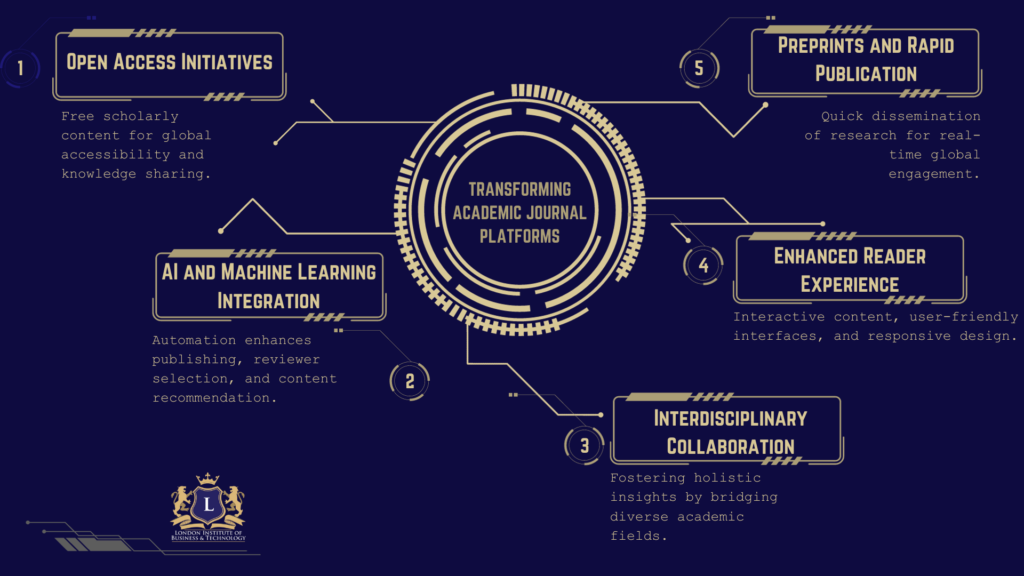Academic journal platforms have long been the gateways to disseminating scholarly research, but in recent years, they have been undergoing a profound transformation. Digital innovation and the evolving needs of the research community have ushered in a new era for academic publishing. This article explores five ways in which academic journal platforms are undergoing a remarkable transformation, shaping the future of academic discourse.

1. Open Access Initiatives
One of the most notable transformations in academic journal platforms is the widespread adoption of open access publishing (source). The shift towards open access publishing in academic journal platforms marks a significant departure from the traditional subscription-based model. In the traditional model, access to academic research articles was often restricted to individuals or institutions that could afford costly subscriptions. This meant that only those with institutional affiliations or substantial budgets, such as universities, could access scholarly research. As a result, a substantial portion of the global population was effectively excluded from accessing the latest scientific and scholarly findings.
Open access initiatives have brought about a fundamental change in this landscape (source). These initiatives prioritize making research freely available to anyone with an internet connection. This means that regardless of your location, educational background, or financial resources, you can access a wealth of scholarly knowledge. Researchers, students, professionals, and the general public can now read, download, and share academic articles without encountering paywalls or access restrictions. Why is this shift important?
- It has expanded the reach of academic work. Research that was previously confined to a limited audience is now accessible to a global readership. This has the potential to amplify the impact of research, as findings can reach a broader and more diverse audience.
- Open access has fostered increased collaboration and engagement within the global research community. When research is openly accessible, it becomes easier for scholars from different regions and disciplines to engage with one another’s work. Researchers can more readily build upon existing knowledge, leading to a deeper and more comprehensive understanding of various subjects. This has the potential to drive innovation, facilitate interdisciplinary research, and accelerate the pace of scientific discovery.
Example of such a change:
1. The Growth of Open Access Journals:
The Directory of Open Access Journals (DOAJ) is a database of open access scientific and scholarly journals. It provides a snapshot of the growth of open access publishing. As of my last knowledge update in 2021, the DOAJ included over 16,000 open access journals covering a wide range of academic disciplines (source). This number has been steadily increasing over the years, indicating the growth of open access publishing.
2. Increased Global Access:
Open access initiatives have significantly increased access to scholarly research worldwide (source). For example, research articles funded by the National Institutes of Health (NIH) in the United States are required to be made openly accessible through the PubMed Central platform. This policy has made thousands of research articles freely available to researchers and the public, contributing to greater global access.
3. Impact on Citation and Collaboration:
Several studies have explored the impact of open access publishing on citation rates and collaboration among researchers. A study published in PLOS ONE in 2018 found that open access articles received more citations on average compared to subscription-based articles (source). This suggests that open access articles are more widely read and referenced by researchers. Additionally, open access publishing can facilitate collaboration among researchers (source) from different institutions and regions, as access barriers are reduced.
4. Increased Public Engagement:
Open access publishing has allowed the general public to engage with academic research more easily (source). For example, universities and institutions often use open access repositories to share faculty research, making it accessible to students, alumni, and the broader community. This engagement can lead to increased interest and support for academic institutions.
2. AI and Machine Learning Integration
Artificial Intelligence (AI) and Machine Learning (ML) have emerged as transformative technologies in the field of academic publishing, reshaping various facets of the publishing process (source). This transformation is driven by the capacity of AI and ML algorithms to perform tasks that were previously time-consuming or relied on manual intervention. The integration of AI and ML in academic publishing offers substantial benefits. Authors experience shorter publication timelines, reduced risk of plagiarism, and better matching with suitable reviewers. This not only speeds up the dissemination of their work but also improves the quality of the peer review process. For readers, AI-driven tools enhance content discoverability, recommend relevant articles, and offer a smoother and more engaging reading experience.
How AI and ML are revolutionizing academic publishing:
1. Identifying Potential Reviewers:
AI algorithms can streamline the process of identifying qualified peer reviewers for academic submissions (source). Traditionally, journal editors had to rely on their networks and time-consuming searches to find appropriate reviewers. AI-driven systems, such as Publons, help by analyzing researcher profiles, publication history, and expertise. These tools match submitted manuscripts with reviewers who possess the necessary knowledge and background. This significantly expedites the review process, ensuring that suitable reviewers are selected quickly and efficiently.
2. Plagiarism Detection:
One of the critical aspects of maintaining the integrity of academic publishing is the detection of plagiarism. AI-powered plagiarism detection software, such as Turnitin and Copyscape, has become indispensable in academic publishing. These tools compare submitted manuscripts with an extensive database of academic and non-academic content to identify instances of plagiarism. Editors and reviewers can then make informed decisions about the originality and quality of the submission. This helps uphold the credibility and quality of academic journals.
3. Enhancing Peer Review:
Machine Learning algorithms can be employed to enhance the peer review process (source). For instance, the platform ScholarOne Manuscripts utilizes ML to predict which reviewers are more likely to accept or decline review requests based on their historical behavior. This ensures that appropriate reviewers are assigned to manuscripts promptly, reducing the time required for the review process. By automating reviewer selection and optimizing the peer review workflow, AI contributes to shorter publication timelines.
4. Automated Article Classification:
AI can be used to classify and tag articles based on their content (source). This makes it easier for readers to find articles of interest within a journal. For example, Springer Nature uses AI to classify articles into research categories, improving discoverability and accessibility for readers. This approach assists both authors, who can reach a more targeted audience, and readers who can access relevant research more easily.
5. Content Recommendations:
AI algorithms are employed to provide readers with personalized content recommendations (source). This functionality enhances the reader experience by suggesting related articles based on the reader’s interests and browsing history. For instance, platforms like Google Scholar use machine learning to recommend articles, making it more likely that readers will discover and engage with relevant research.
3. Interdisciplinary Collaboration
Traditional academic journal platforms have typically focused on specific disciplines. However, the academic landscape is evolving towards interdisciplinary research. As a result, there is a growing demand for platforms that facilitate cross-disciplinary collaboration (source). Innovative journal platforms are now integrating content from diverse fields, fostering holistic insights and facilitating the exchange of ideas across disciplines.
4. Enhanced Reader Experience
Digital transformation has introduced numerous enhancements to the reader experience (source). Interactive figures, multimedia content, and supplementary data are now seamlessly integrated into articles. Additionally, user-friendly interfaces and responsive design optimize the viewing experience across different devices. These improvements make research more accessible and engaging for a broader audience.
5. Preprints and Rapid Publication
Preprint servers and platforms dedicated to rapid publication are gaining prominence in the academic world (source). Researchers can now share their findings quickly, often before the formal peer review process is completed. Preprints are accelerating the dissemination of knowledge and enabling scholars to receive feedback from the community in real-time. This approach complements traditional publishing by providing an avenue for early-stage research to be accessible and discussed.
Conclusion
The ongoing transformation of academic journal platforms is marked by digital innovation, open access initiatives, and the integration of AI and ML technologies. These changes aim to make research more accessible, streamline the publishing process, foster interdisciplinary collaboration, and enhance the reader experience. The LIKE Centre actively contributes to these advancements by focusing on AI-driven tools that optimize scholarly publishing, improve interdisciplinary collaboration, and elevate the reader’s engagement with academic content. As these transformations unfold, the academic world is on the cusp of greater accessibility, efficiency, and interconnectedness, raising questions about how these positive changes can be further nurtured and what future transformations await the field of academic publishing. Considering this, how can we further nurture and amplify these positive changes, and what new transformations lie on the horizon for academic publishing?







Leave a Reply
You must be logged in to post a comment.